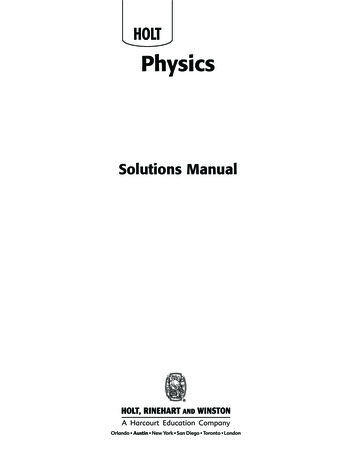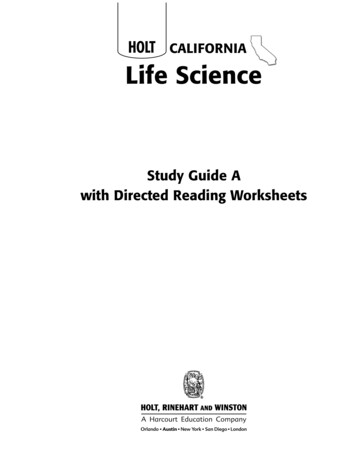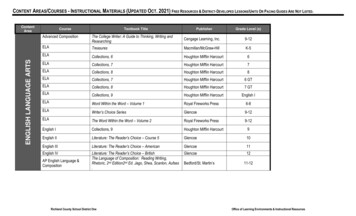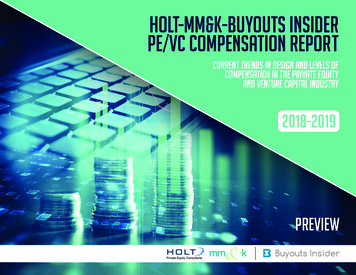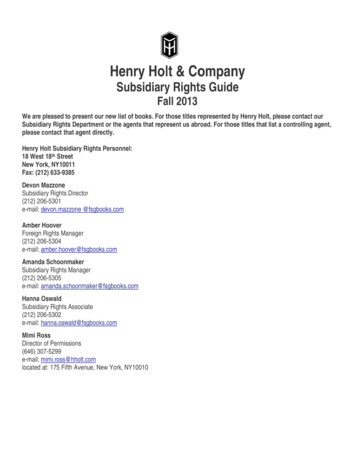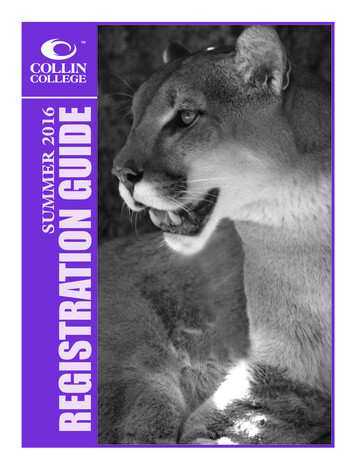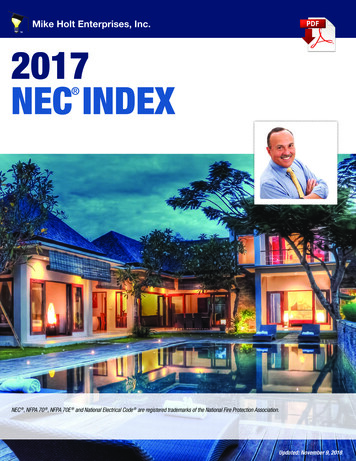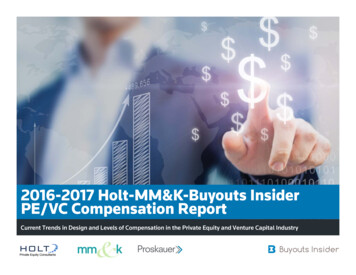
Transcription
2016-2017 Holt-MM&K-Buyouts InsiderPE/VC Compensation ReportCurrent Trends in Design and Levels of Compensation in the Private Equity and Venture Capital Industry
Table of ContentsI. Introduction/Participant SummaryKey FindingsScope and MethodologyAbout the Authors22813II. Financial and Operational DataCommi?ed Capital and Cost of InvestmentsNumber of Funds Managed and Number of Portfolio Companies 17Ownership StructureManagement Fees/Other Fees/Fee Ratios/Fee Splits1516III. Human CapitalNumber of Employees per Employee GroupStaffing Changes 2015/2016Investment Manager Ratios (Capital/Fees/Portfolio Companies)Human Capital Policies/Years to Partner/ MBA Hiring & CompensationPayroll Cost and Total Employees232425272829IV. Compensation StrategyTypes of CompensationSalary & Bonus ChangesAnnual Bonus PlansCarried Interest PlansEmployee BenefitsGeneral Partner Commitment (GPC)Co-Investment Plans3132343840485152V. Year to Year Changes in Compensation LevelsGeographic Differences55VI. Compensation Levels Per Position (By Type & Size of Firm)60VII. Compensation Levels by Type & Size of Firm – North America,Canada, Asia Pacific, & Employee Benefit Costs125 2016 by Holt Private Equity Consultants, MM&K Ltd. and Buyouts Insider. All Rights Reserved1819Survey BackgroundThe 2016-2017 Holt-MM&K-Buyouts InsiderPrivate Equity and Venture CapitalCompensation Report is a joint effort of threeparties. They are compensation consultants HoltPrivate Equity Consultants and MM&K; andglobal private equity publisher Buyouts Insider.It is jointly wri?en by Michael Holt, David M.Toll and Paul Centopani.Copyright InformationData and information in this report is copyrighted bythe authors. Electronic and printed copies of thisreport can only be shared with employees of the firmpurchasing the report. Users are forbidden toreproduce, republish, redistribute, or resell anymaterials from this report to any party who is notemployed at the organization purchasing the report ineither machine-readable form or any other formwithout permission of the authors. No part of thisreport may be copied, photocopied, duplicated orforwarded in any form or by any means without thepublisher’s wri?en consent. Failure to abide by thiswill be considered an abuse of Federal Copyright Law(17 USC 101 et seq.) and may be subject to criminalpenalties and liability for substantial monetarydamages.For permissions and other copyright-related questions,please email your question ateEquityCompensation.comPrivate Equity and Venture Capital – North America Report Page 1
Key FindingsPART 1. Section I. Introduction/Participant SummaryBetween 2015 and 2016, compensation in North American private equity (including venture capital) markets rose sharply for many employees. Salaries and bonusesjumped for both partners and non-partners alike, as evident in Table 1, building on a winning streak that dates back to 2010. Simultaneously, profit distributionsalso rose from last year to this year. The increase in compensation for junior professionals was especially pronounced this year, while senior professionals saw ajump that was fairly comparable to that in the last several years. The continued upward trend in compensation largely results from healthy fundraising, dealmaking and exit markets.Table 1: Changes in Median Compensation, 2007-2016PartnerSalarySalary BonusNon-PartnerSalary Bonus CarrySalaryAllSalary BonusSalary Bonus CarrySalarySalary Salary Bonus 4%24%250.0Table 2: US Buyout/Mezzanine and VentureCapital Fundraising ( 0.00.098.765.828.82009Buyout Mezzanine69.322.7201025.2201124.7 24.12012201337.5201438.1201537.3Venture Capital2016YTD 2016 by Holt Private Equity Consultants, MM&K Ltd. and Buyouts Insider. All Rights ReservedFund-raising, a crucial component in determining compensation, has been growingor holding reasonably steady for both U.S. buyout funds and venture capital funds.Venture fund-raising, in particular, is set to post impressive year-on-year growth in2016, as shown in Table 2.Although limited partners have been pushing for lower management fees, by andlarge buyout firms still charge between 1.5 percent and 2 percent of commi?edcapital during their investment periods, while venture firms charge between 2percent and 2.5 percent. As firms raise more money, they bring in greatermanagement fees. And the greater the management fees, the more money they haveavailable to pay their employees in salaries and bonuses.The 2016-2017 Holt-MM&K-Buyouts Insider Private Equity and Venture CapitalCompensation Report (North American edition) reflects the combined efforts of twocompensation consultancies – Florida-based Holt Private Equity Consultants andLondon-based MM&K – and New York-based publisher Buyouts Insider. The reportis based on an extensive, two-part survey of private-equity firms conducted in thespring and early summer of 2016.All told, 108 organizations participated in the survey. They provided information on4,113 workers, employed in some 30 different positions, from analyst to managinggeneral partner on the investment side of firms, from receptionist to chief operatingofficer on the administrative side. The survey questionnaire consisted of two parts.The first gathered data on firm-wide recruiting and compensation practices, such asthe structure of carried interest and co-investment programs; the second gathereddata on the compensation packages of individual employees.The report itself is divided into seven sections. The first three after the participantsummary cover firm-wide compensation practices for 20 groups of firms organizedby investment strategy, assets under management, and whether affiliated with asponsor company (such as an investment bank). Sections V-VII cover employeecompensation, by job title, for some 24 groups of firms, similarly organized byinvestment strategy, assets under management, and any sponsor affiliation. Formore detailed descriptions of the samples see the Scope and Methodology section ofthis executive summary on p. 8.Private Equity and Venture Capital – North America Report Page 2
Key FindingsSources of RevenuePrivate-equity firms charge their investors, as a management fee, anywhere from 1.5 percent to 2.5 percent of commi?ed capital annually during the investmentperiods of their funds. Those with smaller funds tend to charge higher percentages, although on an absolute basis they bring in less revenue.After the investment period ends, the management fee typically steps down to reflect the reduced workload needed to manage a portfolio that has entered harvestmode, as well as the fact that a firm is often collecting full fees on successor partnerships. In addition to management fees, buyout firms also generate incomethrough deal fees, consulting fees and related fees, although these fees have come under pressure as well. Specifically, limited partners have been pressing to keep ahigher percentage of these fees, to the point where many firms share 80 percent or 100 percent with investors by offse?ing the management fee.According to our survey, the median for management fees, as a percentage of all active funds, is 0.4 percent across all firms in our study – see Table 4 below. ForLBO/Growth Equity firms the median is 0.7 percent while for Venture Capital firms in our study the median is 0.9 percent.Our survey shows that the median private-equity firm devotes 65percent of its total GP fees/revenues to payroll – see Table 3 below.The figure is 56 percent for LBO/Growth Equity firms and 72 percentfor Venture Capital firms.Table 3: Payroll Cost As % of General Partner Fees/Payroll% of General PartnerRevenues (Details arein CostfullAsreport)Fees/RevenuesFirm ClassificationAvg.25th50th75thLBO/VC/Mezz (Large)************LBO/VC/Mezz (Small/Mid-Size)************LBO/VC/Mezz (All)************LBO / Grow th Equity (Large)************LBO / Grow th Equity (Small/Mid-Size)LBO / Grow th Equity (All)Venture Capital (Large)Venture Capital (Small/Mid-Size)Venture Capital 57%***72%***80%Mezzanine (Large)************Mezzanine (Small/Mid)************Mezzanine (All)************Fund of Funds (Large)************Fund of Funds (Small-Mid-Size)************Fund of Funds (All)***************RE/Sec/Co-Inv/Dist (One Size)*********Institutional (Large)************Institutional (Small/Mid-Size)************Institutional (All)************Institutional (All)62%52%65%73%Table 4: Management Fee Ratios. (Details are in full report).Management Fee RatiosFirm ClassificationLBO/VC/Mezz (Large)LBO/VC/Mezz (Small/Mid-Size)LBO/VC/Mezz (All)LBO / Grow th Equity (Large)LBO / Grow th Equity (Small/Mid-Size)LBO / Grow th Equity (All)Venture Capital (Large)Venture Capital (Small/Mid-Size)Venture Capital (All)Mezzanine (Large)Mezzanine (Small/Mid)Mezzanine (All)Fund of Funds (Large)Fund of Funds (Small-Mid-Size)Fund of Funds (All)RE/Sec/Co-Inv/Dist (One Size)Institutional (Large)Institutional (Small/Mid-Size)Institutional (All)All Firms 2016 by Holt Private Equity Consultants, MM&K Ltd. and Buyouts Insider. All Rights ReservedAs a % of All Active FundsAs a % of Most Recent **5.0%******************************3.8%Private Equity and Venture Capital – North America Report Page 3
Key FindingsSources of Revenue (Continued)We know that employee count does not increase in straight-line tandem with assets under management. Private-equity firms that raise larger pools tend tounderwrite larger deals, which don’t necessarily require more resources to transact. In light of this, we would expect salaries and bonuses paid to private-equityemployees at individual firms to be highly correlated with assets under management. And so they are. The more money a firm manages, the more money it tends topay per employee in salary and bonuses.This correlation has been borne out by this and countless prior industry compensation studies. Just one example from last year’s compensation report: SeniorPartners (our 2nd level investment management position) at large buyout firms ( 1.5 billion or more in assets under management) in our survey earned a median(50th percentile) of 1,375,000 in salary and bonus in 2015, compared with 675,000 for their counterparts at small buyout firms (less than 500 million)Table 5: Hurdle Rates to Determine Carried Interest(Details are in full report)In fact, buyout firms in our survey tend to pay more in salary and bonus than do venture firms inpart because they often manage larger funds. In addition, many buyout professionals hail fromthe high-paying field of investment banking, and buyout firms competeto some extent with Wall Street for talent. Venture capitalists tend to haveoperational backgrounds in the less remunerative fields of technology, health care, andconsulting.Firm ClassificationSalaries and bonuses comprise two legs of the compensation stool. The third, and mostimportant to investment professionals, are carried interest distributions. These get paidout of carried interest realized gains, or the 20 percent of investment profits thatprivate-equity firms are typically entitled to keep (usually after meeting a hurdle rate ofreturn). The previous few years have seen a rise in M&A and IPO activity, which in turnhas led to a rise in exits for both buyout and venture capital funds. This increase isreflected in higher carried interest distributions across much of our survey samples.About 80 percent of LBO/Growth Equity firms have a hurdle rate to surpass before anycarried interest distributions, while more than a third of Venture Capital firms must alsomeet a hurdle. For LBO/Growth Equity firms that are dependent upon hurdle rates, themajority must meet a “preferred return” that typically is 8 percent (followed by a“catch-up”)– see Table 5 at right.Firms Using Hurdle Rates to Determine Carried InterestNoHurdleRateUsedNet AssetValue Test% ofFirmsRatePreferredreturn w ithcatch-up% ofFirmsRateThresholdreturn, nocatch up% ofFirmsOther MethodRate% ofFirmsLBO/VC/Mezz36%14%120%75%8%2%8%10%0%LBO / Grow th Equity20%7%110%90%8%0%8%3%0%Venture 8%0%0%10%0%Fund of 20%0%All Firms36%11%120%77%8%1%8%10%0%Needless to say, the private equity markets are not monolithic. Next we take a look atindustry trends that play into compensation payouts in two of the largest marketsub-sectors, LBO/Growth Equity and Venture Capital. 2016 by Holt Private Equity Consultants, MM&K Ltd. and Buyouts Insider. All Rights ReservedRatePrivate Equity and Venture Capital – North America Report Page 4
Key Findings2015-2016 Compensation Trends: Independent LBO/Growth EquityDeal-making in the U.S. buyout market peaked in 2006-2007 before drastically falling and remaining at depressed levels in 2008 and 2009 while recently there hasbeen a recovery and exits have followed a similar track. The recovery in exits has led to a rise in carry distributions for LBO/Growth Equity associates, seniorassociates and partners in 2016 (see Table 6 below).LBO/Growth Equity fundraising has lagged deal-making, as it almost always does, peaking in 2007 and 2008, before falling off in 2009 and 2010—see Table 2. Thisyear (2016) we should witness U.S. buyout firms equal or surpass the amount raised in recent years, while remaining short of the amount raised in 2008.As in other private equity markets, salaries and bonuses at LBO/Growth Equity shops tend to rise fastest during times when firms are raising money, rapidlybuilding up their assets under management, and competing aggressively for talent.Indeed, the boom in fundraising that generates management fees, and deal-making that generates deal fees, fueled a rapid rise in salary and bonus compensationfor both partner and non-partner investment professionals at LBO/Growth Equity firms from 2015-2016 (see Table 6 below). Our data shows that many seniorbuyout professionals enjoyed sizeable carry distributions in both 2015 and 2016.Hiring also tends to go hand in hand with fundraising and deal-making, as firms bulk up to help put more money to work in transactions. According to our survey,47 percent of LBO/Growth Equity firms planned to add non-partner investment professionals to their staffs in 2016, up from 45 percent that actually did in 2015—see Table 7 below. Twenty-one percent of LBO/Growth Equity firms in our sample plan to add partners to their firm this year, indicating that they are allocatingmore resources to human capital in anticipation of more favorable market conditions. In last year’s report, just 14 percent of LBO/Growth Equity firms anticipatedadding partners.Table 6: All LBO/Growth Equity, Common Job Titles, Year over Year Median Compensation.Base Salary ( 000)Job TitleSalary Bonus ( 000)Carry Distribution ( 000)20162015% Change20162015% Change20162015% ChangeManaging General .5-4%Senior Partner/Senior Managing Partner/Managing Director(s)/Portfolio 00.0-46%Vice President(s)/Senior 0242.513%425.0426.00%425.0440.0-3%Table 7: Staffing Changes 2015 and Projected 2016 , Investment Professionals Partners and Non-Partners, LBO/Growth EquityIncrease2015Partners/M.D.Non-PartnersNo ChangeDecrease201620152016% Firms% Change(Median)% Firms% Change(Median)% Firms% Change(Median)% Firms% %0%14%3%3%25%14%66%45%76%50% 2016 by Holt Private Equity Consultants, MM&K Ltd. and Buyouts Insider. All Rights ReservedPrivate Equity and Venture Capital – North America Report Page 5
Key Findings2015-2016 Compensation Trends: Independent Venture CapitalDynamics in the U.S. venture capital market are somewhat different than in the buyout market. The venture capital market is still recovering from an astonishingboom-and-bust period back in the late 1990s and early 2000s. Since then, the industry has been shrinking. Many venture firms that got their start at the tail-end of theboom didn’t survive to raise a subsequent fund, while others scaled back significantly.Meantime, a number of institutional investors, smarting from losses, pulled out of venture capital or ratcheted back their allocations. Deal-making and fund-raisingremain at well below peak levels. Although both have been on the rise over the last few years (Table 2, p. 2), much of the fundraising activity has been concentratedamong a handful of brand-name firms. Nevertheless, this has translated to significant increases in salary and bonus for investment professionals at Venture Capitalfirms in our sample (Table 8 below).A healthy exit market, both for M&A and IPOs, infused the venture market with new life from 2013 to 2016, raising hopes for an even greater pick-up in fundraisingin the months ahead. According to our survey, the turnaround has resulted in a significant uptick in salary, bonus and carry distributions for many professionals in2016 (Table 8 below). As for staffing, more Venture Capital firms (50 percent) planned to hire investment professionals at the non-partner level in 2016, comparedwith what they actually did in 2015. Simultaneously, a relatively high 34 percentage of Venture Capital firms planned to add partners this year, a higher percentagethan their buyout counterparts (see Table 9). In last year’s report just 19 percent of Venture Capital firms planned to add partners.Table 8: All Venture Capital, Common Job Titles, Year over Year Median CompensationTable 9: All Venture Capital, 2015 Staffing Changes and Projected 2016, Investment Pros, Partners and artners2016No Change20152016% Firms% Change(Median)% Firms% Change(Median)% Firms% Change(Median)% Firms% 4%13%16%0%3%N/A50%59%58%66%47% 2016 by Holt Private Equity Consultants, MM&K Ltd. and Buyouts Insider. All Rights ReservedPrivate Equity and Venture Capital – North America Report Page 6
Key FindingsHuman CapitalIn 2016, the median commi?ed capital per partner is 147.0 million in our sample of LBO/Growth Equity firms and 138.9 million in our sample of Venture Capitalfirms for all active funds (see Table 10 below). The comparable figures in last year’s edition of this report were 240.1 million and 140.8 million, respectively.Venture Capital firms report that they have 9.0 portfolio companies per partner (median), nearly twice the 3.4 reported by Buyout/Growth Equity firms in oursample. They have 4.6 portfolio companies per investment professional, much higher than 1.3 for Buyout/Growth Equity firms.Table 10: Investment Manager RatiosFirm ClassificationLBO/VC/Mezz (Large)LBO/VC/Mezz (Small/Mid-Size)LBO/VC/Mezz (All)LBO / Grow th Equity (Large)LBO / Grow th Equity (Small/Mid-Size)LBO / Grow th Equity (All)Venture Capital (Large)Venture Capital (Small/Mid-Size)Venture Capital (All)Mezzanine (Large)Mezzanine (Small/Mid)Mezzanine (All)Fund of Funds (Large)Fund of Funds (Small-Mid-Size)Fund of Funds (All)RE/Sec/Co-Inv/Dist (One Size)Institutional (Large)Institutional (Small/Mid-Size)Institutional (All)All FirmsCommitted Capital (All Active Funds) Per Investment Manager ***********************308.1Partner / M.D.25th 50th******************************32.9 147.0************31.6 ***************42.0 ********************292.5All Investment ProfessionalsAvg. 25th 50th **************104.9 12.1 54.2 122.9************************83.8 16.0 70.4 *************************126.5 17.0 62.8 118.1 2016 by Holt Private Equity Consultants, MM&K Ltd. and Buyouts Insider. All Rights ReservedManagement Fees Per Investment Manager - *******************3.5Partner / M.D.25th **2.1******************************4.1All Investment ProfessionalsAvg. 25th 50th lio Companies Per Investment ******************8.5Partner / M.D.25th ***11.8******************************12.3All Investment ProfessionalsAvg. 25th 50th e Equity and Venture Capital – North America Report Page 7
Scope and MethodologyPART 2. Sections II - IV: Strategy and DesignPART 2. Sections II - IV are the qualitative or "How" sections of the report. We collected and analyzed data concerning financial and operations information; humancapital practices; and the design of compensation plans including salary, bonus/incentive plans, carried interest plans, co-investment plans, general partnercommitment and employee benefits. Although this is 2015 information, we believe it can be helpful in planning for 2016.PART 2. Sections II - IV Firm Classifications:We classify firms by type and by commi?ed capital to all active funds.Altogether we created 20 sample groups to complement our discussion offirm-wide compensation issues (Sections II-IV of report). The smaller samples(ie. Large VC or small/mid-size VC) correspond to your peer groups; the largersamples (ie. All Firms) showcase broader industry trends.* LBO/VC/Mezz: Combines LBO / Growth Equity / VC, and Mezzanine firms intoone “Catch-All” category with a standard 20% carried interest!!!!!!!! Large: firms with 1.2 Billion plus in commi?ed capital (all active funds)! Small/Mid-Size: firms with less than 1.2 Billion in commi?ed capital (allactive funds)! All FirmsLBO / Growth Equity:! Large: firms with 1.2 Billion plus in commi?ed capital (all active funds)! Small/Mid-Size: firms with less than 1.2 Billion in commi?ed capital (allactive funds)! All FirmsVenture Capital:! Large: firms with 1.2 Billion plus in commi?ed capital (all active funds)! Small/Mid-Size: firms with less than 1.2 Billion in commi?ed capital (allactive funds)! All FirmsMezzanine (same three categories as above)Fund of Funds (same three categories as above)Corp Venturing/Secondary/Co-Invest/Real Estate/Infra (Catch all - All firms)Institutional (same three categories as above)All Firms (includes all investment types as described above) 2016 by Holt Private Equity Consultants, MM&K Ltd. and Buyouts Insider. All Rights ReservedSample CharacteristicsThe table below shows you the number of firms populating each of the 20sample groups used in Sections II-IV of this report covering firm-widecompensation practices. You can also see the make-up of each sample interms of assets under management (commi?ed capital, all active funds).Table 11: Firm Size StatisticsCommitted Capital (Millions)Firm ClassificationAll Active Funds# FirmsAvg.25th50th75thLBO/VC/Mezz zz ezz (All)831,587.95218.77915.001,756.39LBO / Grow th Equity (Large)193,065.791,400.002,100.003,538.53LBO / Grow th Equity (Small/Mid-Size)19970.7994.65300.00635.05LBO / Grow th Equity (All)382,018.29229.501,025.002,325.00Venture Capital (Large)132,164.301,320.001,498.002,400.00Venture Capital (Small/Mid-Size)19407.97108.50310.00733.00Venture Capital (All)321,121.48211.15929.001,358.25Mezzanine (Large)72,762.161,525.001,909.002,856.85Mezzanine (Small/Mid)7383.24185.00350.00556.35Mezzanine (All)141,572.70379.501,046.201,819.25Fund of Funds (Large)96,989.441,500.002,000.0010,000.00Fund of Funds (Small-Mid-Size)5395.65123.26150.00600.00Fund of Funds /Dist (One Size)91,046.89200.001,000.001,410.00Institutional onal tional (All)212,999.73430.001,513.003,300.00All Firms1282,124.22287.501,062.502,000.00Private Equity and Venture Capital – North America Report Page 8
Scope and MethodologyPART 3. Section V - VII : Compensation DataLevels Of Compensation:For each sample statistic we typically show average, 25th percentile, median and 75th percentile. Always bear in mind that the average could be influenced byparticularly high or low data points in the sample, especially if the sample size is small. Most firms that use compensation surveys set compensation targets betweenthe median and the 75th percentile.Firm-Weighted Data versus Incumbent-Weighted Data:Compensation reports based on employee surveys may show data on either an incumbent-weighted or a firm-weighted basis. Incumbent-weighted samples simplyinclude all employees in the sample, even if a significant percentage of them all work for the same firm; the results may therefore be unduly influenced by one ormore firms and won’t be representative of the overall marketplace. We can correct for this potential flaw by calculating the data on a firm-weighted basis. Forexample, assume there are 10 firms in a survey and nine firms have one incumbent on a position and one firm has 10 incumbents. The firm with 10 incumbentswould affect over 50% of the data. However, if we average the 10 incumbents in the one firm and treat them as one, we eliminate this issue. (When we combine allsizes of data, we modify between the employee and firm data by weighting small firm data once; mid-size data twice; and large size data three times.)Mix of Compensation Types:In our employee compensation tables we show salaries; salaries plus bonuses; and carried interest distributions. However, firms in our samples may view the mixof these compensation components in different ways, and give more emphasis to one or the other. Venture firms tend to pay high salaries and low bonuses, whilebuyout firms, with their roots in investment banking, tend to pay lower salaries and larger bonuses. Most firms see carried interest as the most importantcompensation component – at least for higher level employees – as it rewards long-term positive performance on behalf of the firm and its investors. In light of this,well-established firms whose partners already have a high net worth may well pay relatively low salaries and/or bonuses. This of course can vary based on theamount of management and other fees that are received as revenues.Carry DistributionsHistorically, we have added carried interest distributions to salary plus bonus. There is a “flaw” in this approach because many firms do not report the distributions.They may consider the data confidential or simply do not wish to take the time to report them. Thus, if ten firms report salary plus bonus, but only five of themreport distribution we still have been dividing by ten to obtain salary plus bonus plus distributions. Starting in 2014, we do not add the distributions to salary plusbonus. We show the distributions separately but only for those that reported a distribution. (From our above example, we divide by five rather than ten). Firms candecide for themselves how to use this data.Carried Interest Plan Allocation:Where applicable, we show three carried interest allocations. The first is the percent of the most recent fund allocated to each employee as carried interest, alsoreferred to as carried interest points. Employees typically share the 20 points of carry allocated to the GP, although a portion may be allocated to a parent company,or held in reserve for future hires and promotions. We also show the carried interest “dollars at work” for the most recent fund, which is the carried interest pointsassigned an employee multiplied by the size of the fund. For example, a partner with 1 point of carry on a 100 million fund has 1 million at work in that fund—inother words, the dollars at work that can result in realized investment gains. We also show the most important feature of carried interest - the dollars at work for allactive funds. 2016 by Holt Private Equity Consultants, MM&K Ltd. and Buyouts Insider. All Rights ReservedPrivate Equity and Venture Capital – North America Report Page 9
Scope and MethodologyPART 3. Sections V - VII: Compensation DataPART 3. Sections V – VII are the quantitative or "How Much" sections of t
The 2016-2017 Holt-MM&K-Buyouts Insider Private Equity and Venture Capital Compensation Report (North American edition) reflects the combined efforts of two compensation consultancies - Florida-based Holt Private Equity Consultants and London-based MM&K - and New York-based publisher Buyouts Insider. The report is based on an extensive .
